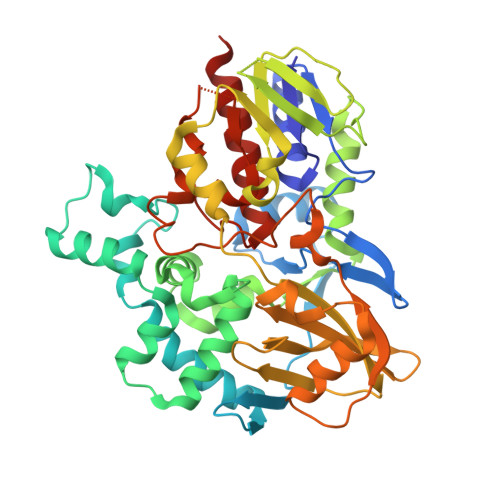Structural Insights into the Substrate Range of a Bacterial Monoamine Oxidase.
Muellers, S.N., Tararina, M.A., Kuzmanovic, U., Galagan, J.E., Allen, K.N.(2023) Biochemistry 62: 851-862
- PubMed: 36662673
- DOI: https://doi.org/10.1021/acs.biochem.2c00540
- Primary Citation of Related Structures:
8EEF, 8EEG, 8EEH, 8EEI, 8EEJ, 8EEK, 8EEL, 8EEM, 8EEN, 8EEO - PubMed Abstract:
Monoamine oxidases (MAOs) play a key role in the breakdown of primary and secondary amines. In eukaryotic organisms, these enzymes are vital to the regulation of monoamine neurotransmitters and the degradation of dietary monoamines. MAOs have also been identified in prokaryotic species, although their role in these organisms is not well understood. Here, we report the biophysical and structural properties of a promiscuous, bacterial MAO from Corynebacterium ammoniagenes ( ca MAO). ca MAO catalyzes the oxidation of a number of monoamine substrates including dopamine and norepinephrine, as well as exhibiting some activity with polyamine substrates such as cadaverine. The X-ray crystal structures of Michaelis complexes with seven substrates show that conserved hydrophobic interactions and hydrogen-bonding pattern (for polar substrates) allow the broad specificity range. The structure of ca MAO identifies an unusual cysteine (Cys424) residue in the so-called "aromatic cage", which flanks the flavin isoalloxazine ring in the active site. Site-directed mutagenesis, steady-state kinetics in air-saturated buffer, and UV-vis spectroscopy revealed that Cys424 plays a role in the pH dependence and modulation of electrostatics within the ca MAO active site. Notably, bioinformatic analysis shows a propensity for variation at this site within the "aromatic cage" of the flavin amine oxidase (FAO) superfamily. Structural analysis also identified the conservation of a secondary substrate inhibition site, present in a homologous member of the superfamily. Finally, genome neighborhood diagram analysis of ca MAO in the context of the FAO superfamily allows us to propose potential roles for these bacterial MAOs in monoamine and polyamine degradation and catabolic pathways related to scavenging of nitrogen.
Organizational Affiliation:
Department of Chemistry, Boston University, Boston, Massachusetts02215, United States.
















